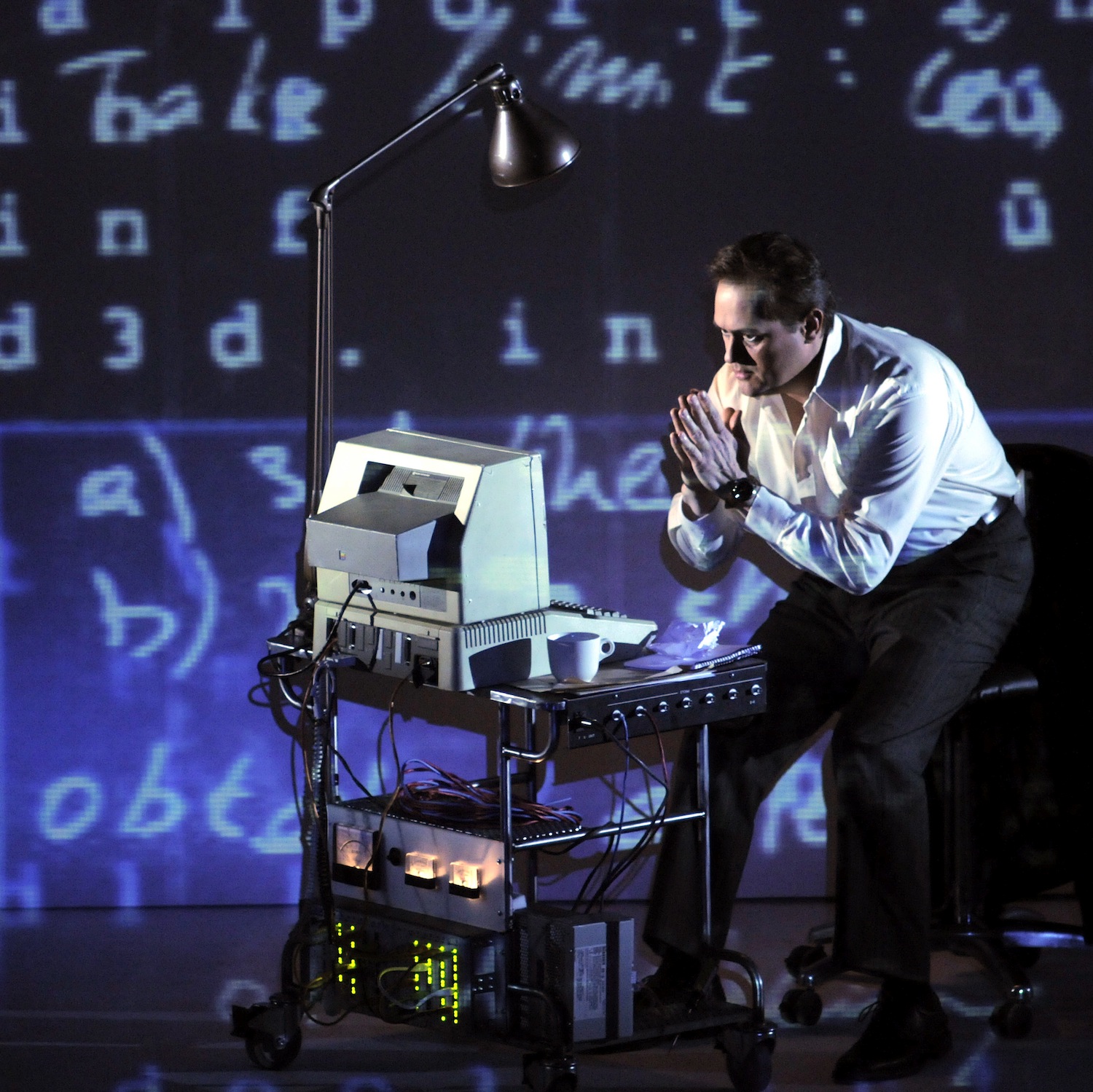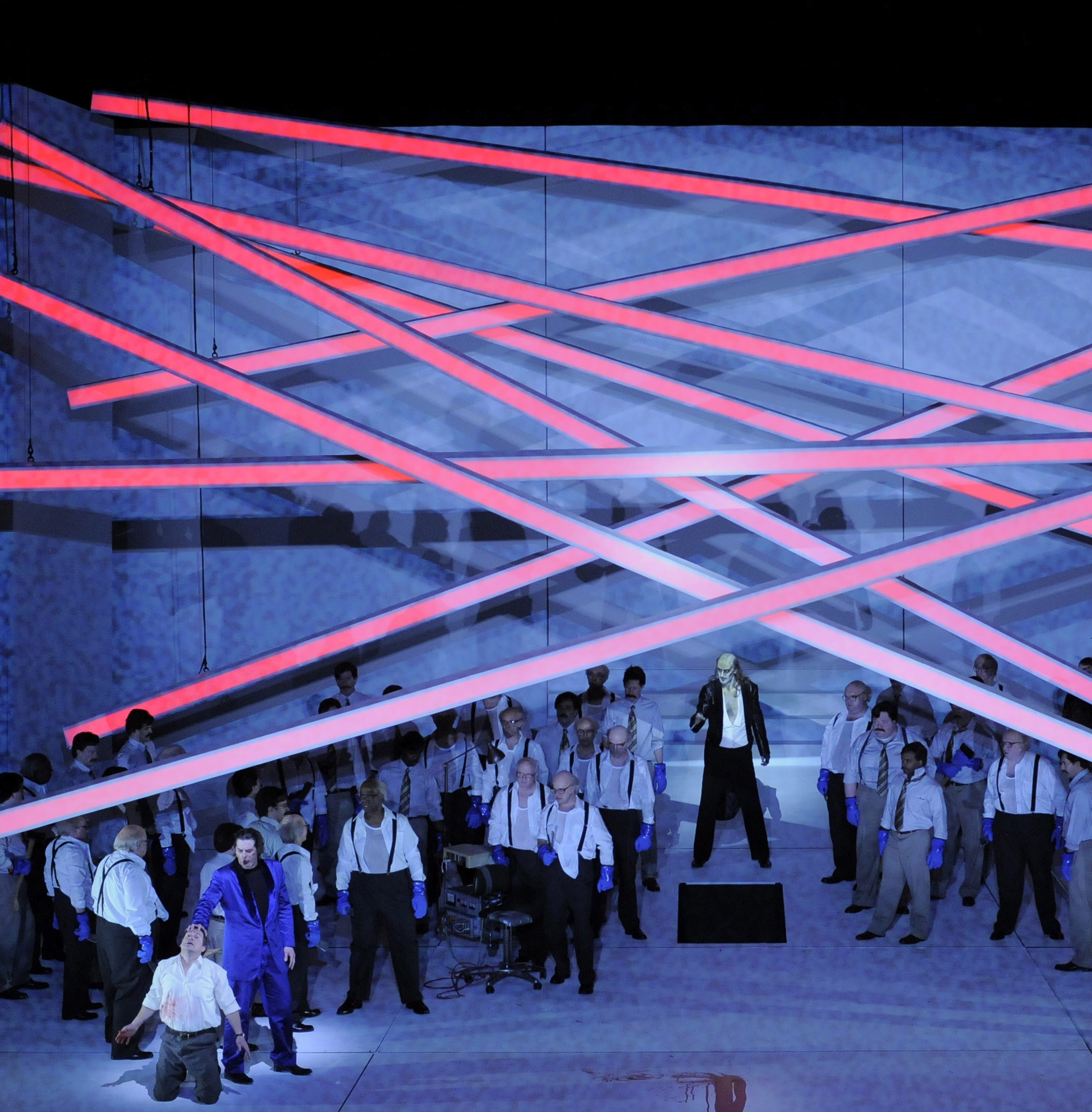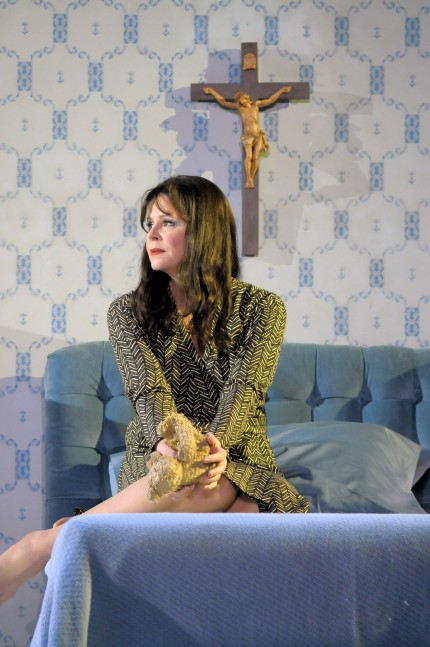Glorious singing trumps audacious but muddled production in Lyric Opera’s “Damnation of Faust”
Even more than Beethoven and Schubert, Hector Berlioz personified the dawn of Romanticism in music—to the extent that when the muse seized him, he would dive feverishly into composition without being too concerned just which genre he was writing for.
Such is the dilemma facing those today who attempt to present The Damnation of Faust. Berlioz’s Legende dramatique is neither fish nor fowl, too orchestral and episodic for the opera house—as Berlioz himself noted—yet more theatrical and grandly conceived than the usual polite oratorio.
What La Damnation does contain is much glorious music— soaring arias for Faust and Marguerite, a drop-dead beautiful duet, riveting scene for trio and chorus, and several brilliant orchestral highlights that have found a regular home in the concert hall.
Berlioz received his belated debut at the Lyric Opera of Chicago with a new production of La Damnation de Faust, which opened Saturday night.
Give the Lyric credit for tackling Berlioz’s short but structurally challenged work, and for allowing its creative team free rein. While Damnation contains some of the French composer’s finest music, it remains a ramshackle collection of twenty short scenes, requiring a fresh, unifying vision to shape it into a coherent whole.
Sadly, that didn’t happen. The vocal side of the evening was supremely well served Saturday by Paul Groves, Susan Graham and John Relyea, the last making a sensational house debut as Mephistopheles.
Yet while the Lyric’s new production offers some stunning visuals, ultimately what emerges is a muddled, chaotic affair, weighed down by an excess of postmodern irony, and several baffling directorial inspirations that tend to undermine the singers’ best moments rather than illuminate.
George Souglides has come up with an audacious scenic motif for the tale of the scientist Faust who sells his soul to the Mephistopheles and destroys the innocent Marguerite in the process. The Greek designer has fast-forwarded the action to an unnamed authoritarian Eastern European country, set in what looks like the early 1960s.
Faust is a kind of Everyman lab clerk, with the chorus, moustached businessmen or bald-pated seniors, the women dowdy housewives, all drably clad in grays and greens.
Souglides’ mutable bi-level set is the most successful element of the production with effective use of an elevated platform in a variety of guises. The designer said his visuals were inspired by the gothic noir of photographer Gregory Crewdson, but the boxed assemblages of Joseph Cornell seem a more direct link, as with the raised miniature cell for Faust’s low-tech office and Marguerite’s plain bedroom.
Director Stephen Langridge has come up with some ideas that worked: the military platoon that engages in drills and calisthenics during the extended Hungarian March, and updating Auerbach’s tavern cellar to a strip club, complete with screaming pink neon and pole dancers.
Yet more often than not, Langridge’s stage action proved more confusing than distinctive, with relentless, overcaffeinated traffic for the lack of any better ideas. The evocation of the Will o’ the Wisps was painted with dancers doubling and tripling Marguerite and Faust, the Marguerite clones bearing cups of coffee through both doors of her house in dizzying appearances and reappearances. So annoying was the result that you wanted Marguerite’s silent heavy-set mother to get up, lock the door and stop all the nonsense.
Equally bizarre was the devil apparently inhabiting the soul of Brander in the club scene, with Christian Van Horn made up in Kiss-meets-Marilyn Manson style, singing his song of the rat with hand-held mike. As the evening continued, the directorial conceits seemed more desperate and less allied to the actual libretto.
John Boesche, who contributed that memorable Expressionist-style film in the company’s production of Lulu last season, was set to provide similar projections for this show. Yet apart from Faust’s equations cleverly appearing on the back screen during the opening scene and fitful light swirls, Boesche’s work appeared to be missing in action, much of it apparently dropped before opening night.
The climactic and impossible-to-stage scene of Faust and Mephistopheles’ horseride to hell and ensuing Pandemonium seemed to suffer the most from Boeshe’s non-presence. With Faust outfitted with virtual-reality goggles, it seemed the stage was set for a wild cinematic succession of images. But instead all the weird characters just reappeared on stage—Brander-Satan, the strippers, stroller-pushing maids, and, for some reason, a pregnant woman writhing on the ground who seemed left over from last fall’s Gounod production.
Vocally, however, the evening was virtually faultless. Paul Groves made a fine Faust in his business attire, as much an observer as participant in all the ongoing strangeness. Groves brought fine commitment and urgency to this rather thankless role, singing with a firm yet supple tenor and rendering a particularly fine invocation to Nature, some thinness in the stratospheric top notes apart.
Berlioz’s Marguerite has long been a favored role for Susan Graham and the popular American mezzo gamely entered into the production’s demands. While the staging’s heavy irony tended to override the human drama, her sensitive singing still provided the most affecting moments. Graham delivered a beautifully sung King of Thule Ballad and a heartbreaking rendition of D’amour l’ardente flamme, the latter unfortunately undermined by the hectic stage action of Margeurite’s arrest.
John Relyea is the real thing, a young American bass-baritone with a vast sonorous instrument capable of impressive agility, as displayed in a witty rendition of Mephistopheles’ Song of the Flea. Clad in a snazzy electric-blue suit, Relyea showed fine stage command and sang with immense power and expressive point, painting a villain both charismatic and suavely menacing.
The gifted Christian Van Horn made the most of his brief but unsettling duo turn as Satan-rocker-Brander.
But it is the chorus that is the fulcrum of Damnation and the eighty men and women of the Lyric Opera Chorus deserve the highest accolades. Outfitted in a variety of bizarro getups, the Lyric ensemble characterized vividly and sang magnificently under Donald Nally’s excellent direction. The assorted dancers, choreographed by Philippe Giraudeau, fulfilled their assignments with grace and style.
Berlioz’s score is symphonic nearly as much as vocal, and Sir Andrew Davis and the Lyric Opera Orchestra provided their finest playing of the season, which is saying something. From the brassy swagger of the Hungarian March to the delicacy of the Dance of the Sylphs and luminous textures of the final scene, Sir Andrew and company delivered subtly colored and beautifully nuanced playing. Special kudos to Robert Morgan’s evocative English horn solo in Marguerite’s Act 2 Romance.
Berlioz’s The Damnation of Faust runs through March 17. www.lyricopera.org; 312-332-2244.
Posted in Performances








Posted Feb 22, 2010 at 3:00 pm by Opera Fan
The first half of the production had rats dancing strip tease and a computer screen backdrop. I did not stay for the second act.
Posted Mar 03, 2010 at 9:00 am by Judy
It was visually annoying – hard to see (like Hollywood Squares) and hard to follow. The visuals overpowered the music. Many people in the audience were reading their program with little flashlights to try to follow what was going on. I left before it ended. Couldn’t take it anymore. Just plain awful.
Posted Mar 03, 2010 at 2:11 pm by Chris
While this review does make several good points, the fact that so many people found the visual aspects of the production overpowering – and the two prior comments seem to echo this sentiment – speaks to a troubling trend (or perhaps lack-of-trend) in opera. Why is there such a need for linearity and hyper-realism? The mention of the “annoying” evocation of the Will-o-Wisps seems to indicate a lack of attention and care for the larger picture (because surely they couldn’t have sequential occurrences of the same action happening simultaneously on stage – that would just be madness!).
Similarly, the comment about the lack of connection between the libretto and stage action feels somewhat hasty, as does the consignment of the staging as “ironic.” I did not feel that the leap from the lyrics being sung to the action on stage was very difficult to make; the physical action for the most part is realized as a thematic parallel to the text. It is, in effect, two versions of the same story.
As was pointed out in the program notes, Berlioz’ imagination produced a “cinematic” stage piece, and Mr. Langridge’s direction echoed the artistic language of film with subtlety and skill. While I agree that the second half was more muddled – and I would have loved to see more projections, particularly in Faust’s ride in Part IV – such harsh criticism of the directorial concept and technical design (as well as calling the piece itself “structurally challenged”) ignores nearly 120 years of theatrical and cinematic innovation. Traditionalists may boo the new and abstract, but it is productions like the Lyric Opera’s “Damnation of Faust” that will attract future generations of opera-goers and prevent the irreparable stagnation of an art form.
Posted Mar 05, 2010 at 9:27 am by Patrick Vance
I am new to opera, but I found this production creative and thrilling. The onstage design elements complimented perfectly with the libretto. The music and singing were impressive. This is the kind of production that will reach newer audieces. We have also seen Faust and The Marriage of Figaro this season, I think this imaginative interpretation shows the artistic power of the Lyric. They can stage the traditional as well as break new ground. The production was artisticly bold and inkeeping with the original composers vision. Bravo Lyric artists, Bravo!
Posted Mar 05, 2010 at 11:41 pm by Opera student
I have just returned from seeing the Lyric’s
production of “the Damnation of Faust”. What a disappointment. Old, post-modern concepts trying to invigorate where none is needed, movement on stage destroying subtlties of the music…where did we get George? Many left at
the half-time of this game. The staging was so busy the other half had headaches. This was not innovative. it was challenging to stay to the end! Mr. Mason, how much did you waste on this production? The music doesn’t need all of this distraction and annoying movement and irrelevant interpretation by the supporting staff. this is the kind of work that will alienate existing subscribers and keep new ones from attending. Talk about anti-art!
Posted Mar 06, 2010 at 3:42 pm by Karen Perry
The only thing I haven’t heard about this production is that it was dreary and boring as hell (pun intended). ELO did a better light show back in the seventies. What was all that silliness w/ the doors and the jacket? Put the jacket on, take the jacket off, in the door, out the door, put the tie on, take the tie off, in the door, out the door etc etc etc. Finally just shut my eyes and enjoyed the music-which was wonderful. Two people from our box walked out at intermission as did everyone from the box to our left. Half of those in the box to our right also bailed. Maybe the critics loved this production, but the “fans” definitely did not.